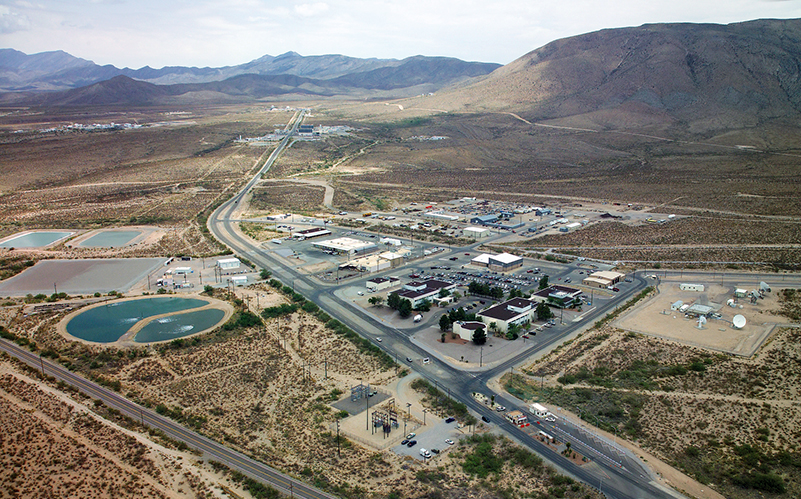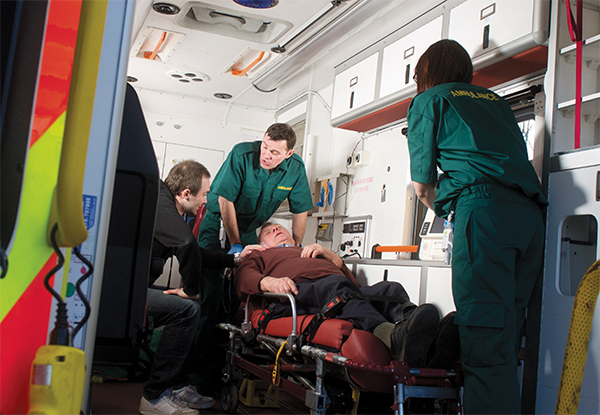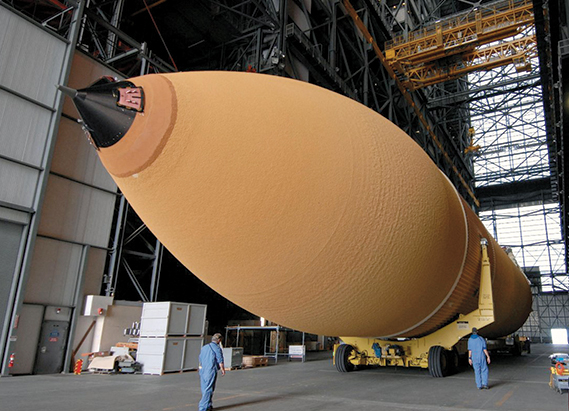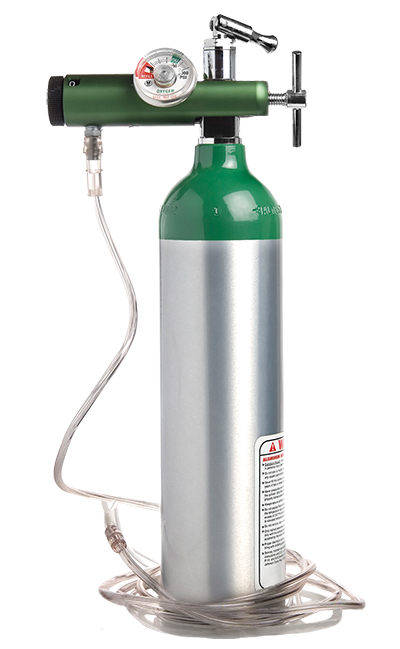
Oxygen Assessments Ensure Safer Medical Devices
NASA Technology
Alongside the tragedies that are part of the history of human spaceflight, bittersweet lessons have been learned. These lessons have not only taught us about the extreme requirements of space travel; they have taught us how to live more safely on Earth.
When the first Apollo mission to carry humans to the Moon ended in a fire that took the lives of three astronauts, NASA undertook a thorough investigation. The final accident report identified a lack of understanding concerning the dangers posed by the use of pure oxygen inside a spacecraft.
Fire requires three things: fuel, oxygen, and a source of ignition. While it may sound like a simple formula, starting a fire can become quite complicated because the fuel, sources of ignition, and amounts of oxygen vary dramatically from place to place. Consider the fact that some materials are not flammable in air at all, which has approximately 21 percent oxygen, but become flammable in a slightly higher oxygen environment composed of just 23 percent oxygen.
Joel Stoltzfus, an engineer at Johnson Space Center’s White Sands Test Facility (WSTF), knows just how hazardous an oxygen-rich environment can be. “The general problem is that, as oxygen concentration and pressure increase, the fire hazard increases. As you increase the pressure, more oxygen is available, and things burn better,” he explains.
Since before the Apollo program, NASA has studied the flammability and ignitability of materials. The Agency has tested everything from materials designed for use inside oxygen-rich environments like spacecraft to the materials used on the tanks that stored liquid oxygen for the space shuttle main engines. Over the past five decades, NASA has become a go-to source for expertise about materials, flammability, and oxygen-rich or high-pressure oxygen environments.
Stoltzfus describes how, in the early 1980s, WSTF developed a process to determine the oxygen fire hazard associated with a component or system. “We ended up capturing the thinking in a way that could be explained and taught,” he says. “We wanted to help share information on what materials should be used in systems with oxygen to control the hazard.”
Called the oxygen compatibility assessment (OCA), the procedure evaluates the fire hazard in oxygen-enriched environments and has been adopted by NASA, the American Society for Testing and Materials (ASTM), and the International Organization for Standardization. ASTM incorporates the procedure as part of its recommended practices to ensure oxygen safety. As of 2012, WSTF had conducted over 400 OCAs for the International Space Station, space shuttles, ground support equipment, and rocket engine components and test systems.
Over the years, WSTF has created manuals and training courses to teach oxygen compatibility standards. The facility also partners with other organizations to develop training materials and to perform hazard and failure analyses. Alongside the OCA, WSTF devised a unique test method to determine which metals and alloys are flammable, and at what conditions. Now patented by WSTF, the method is being used to answer questions about the burning behavior of metal alloys. “This test method enables you to know which materials support burning and which ones do not,” says Stoltzfus.
While WSTF’s test methods, analyses, and training are of extreme benefit to the aerospace community, the valuable information they contain also applies to other fields. Today, WSTF specializes in the study of oxygen compatibility in space, aircraft, medical, and industrial applications. “We investigate the effects of increased oxygen concentration on the ignition and burning of materials and components used in these applications,” says Stoltzfus.
Technology Transfer
Throughout the 80s, one of Stoltzfus’ colleagues at WSTF was Barry Newton. Together, Newton and Stoltzfus gained years of experience testing materials and components in high-pressure oxygen and performing failure analyses on components and systems.
In 1988, Newton testified for an oxygen safety legal case while at NASA and enjoyed the forensic challenge. Because of his positive experience, he soon went to work for Wendell Hull and Associates (WHA), an engineering firm in Las Cruces, New Mexico, started and owned by his father in law.
“At that time, the company did not do any oxygen testing, but it began doing oxygen fire forensic origin and cause evaluations due to my background and training received at WSTF,” says Newton, now vice president of research and development at WHA. “The WSTF capability and technology was the starting point for virtually all of the firm’s oxygen testing technology. There has been a huge impact on our business from what we learned at WSTF, and what we continue to do in collaboration with WSTF.”
Today, WHA specializes in fire and explosion investigations, oxygen and hydrogen testing and safety training, and accident reconstruction and forensic engineering. Besides Newton, the firm employs four engineers and one technician who also started their work on oxygen system safety at WSTF.
In addition to having expertise acquired at WSTF, Newton appreciates the partnership the firm has through a Space Act Agreement with NASA. “We bring a number of clients to WSTF to use their special test capabilities every year that otherwise wouldn’t know where to have it done,” says Newton. “It also allows for a pipeline of activity, including testing, to flow from WSTF to private industry and vice versa.”
Benefits
As a provider of forensic analysis of oxygen-related fire investigations, WHA also provides training around the world—from Canada to Australia and Nigeria—largely focused on oxygen distribution, oxygen component design, and medical oxygen supply and treatment. “We help them to understand the relationship between materials and flammability,” says Newton. “We educate people on the hazards and provide the tools to fire-harden their devices.”
In total, WHA trains an estimated 500–750 students per year at its own facility, at customer locations, and by e-Training—ranging from training on oxygen pipeline and distribution to oxygen use at chemical processing plants to medical component and device manufacturing.
According to Newton, “Oxygen is being used to a greater degree now than ever before. Fires are occurring in almost every industry that uses oxygen.”
One area where oxygen fires occur is the medical industry. According to Newton, “From what we are seeing, the health and medical industry gets hit by the largest number of fires. Statistics indicate there are over 600 oxygen-related fires in medical treatment facilities and hospitals each year. Many more are occurring inhealthcare settings.”
As an example, back in 1999, the Food and Drug Administration and the National Institute of Occupational Safety and Health released a public health advisory about explosions and fires in aluminum oxygen regulators. These regulators convert compressed oxygen to a safe pressure for patients to inhale in an emergency situation, in ahealthcare setting, in hospitals, and in industrial settings.
“The reason they started having fires is the manufacturers started making them out of aluminum, which is very flammable in oxygen,” says Stoltzfus. “If you have high pressure oxygen in a container at a high oxygen concentration, and the material construction of that container is flammable, the fire hazard is pretty significant.”
WHA, along with WSTF and several other organizations, performed tests on the regulators and then devised a new ASTM International standard for devices that deliver oxygen. The standard specifies that the devices must demonstrate resistance to burn out when they are exposed to an intentional, internal ignition source. Since the standard’s inception, no devices that met the standard have experienced any component burnout fires.
Inhealthcare, Newton says there have been a large number of oxygen fires from high-pressure cylinder breathing systems, low-pressure-concentrator breathing systems, and liquid oxygen systems. Such equipment supplies oxygen to people with breathing problems while at home, shopping, or traveling. In medical facilities where patients receive 100 percent oxygen, Newton says fires have resulted from the breathing tubes when a heat-producing laser is used during surgery.
Additionally, oxygen hoods and hyperbaric chambers, which produce a 100-percent oxygen environment for patients to receive oxygen therapy to promote healing, have also experienced accidents—but with less frequency. “We are currently working with the hyperbaric industry on specific standards and test methods for qualifying materials and devices that go into hyperbaric chambers at healthcare facilities offering hyperbaric treatment,” says Newton.
A new area that WHA is working on is to help qualify medical devices called valve integrated pressure regulators (VIPRs) for use in the United States. WHA is being consulted to ensure that the devices, which integrate the valve and medical regulator on medical oxygen regulators, are safe. “There have been quite a few fires in VIPRs in Europe,” says Newton. “We’re currently testing different types for the United States and Europe and are working with WSTF, ASTM International, and the FDA to revise the test standard for VIPRs.”
WHA is working daily with industries on a variety of new technologies. “Pressures and concentrations are increasing,” says Newton. “If you can get more oxygen in same bottle, it lasts longer. Companies come to us to learn how to prevent fires.”
For Newton, this just shows how “NASA is important to us all.”
“We work hand in hand all the time,” he says, “and there’s been a huge movement of technology from NASA into industry.”

The medical industry, including emergency response personnel, benefit from NASA’s expertise on materials, flammability, and oxygen-rich environments

An external tank holding liquid hydrogen and liquid oxygen for the now-retired space shuttle arrives at the Vehicle Assembly Building at Kennedy Space Center. To ensure safety, NASA studied and tested the materials used on the tank for ignitability and flammability.

Oxygen regulators convert pressurized oxygen to a safe level for patients to inhale. When the regulators started experiencing fires and explosions, Wendell Hull and Associates worked with NASA and others to devise a new safety standard for the devices.

Johnson Space Center’s White Sands Test Facility in Las Cruces, New Mexico, is a center of technical excellence in high-pressure oxygen systems/materials and rocket propellant safety. Among other services, the facility provides failure analyses of materials and systems, system evaluation tests, and safety training courses.













